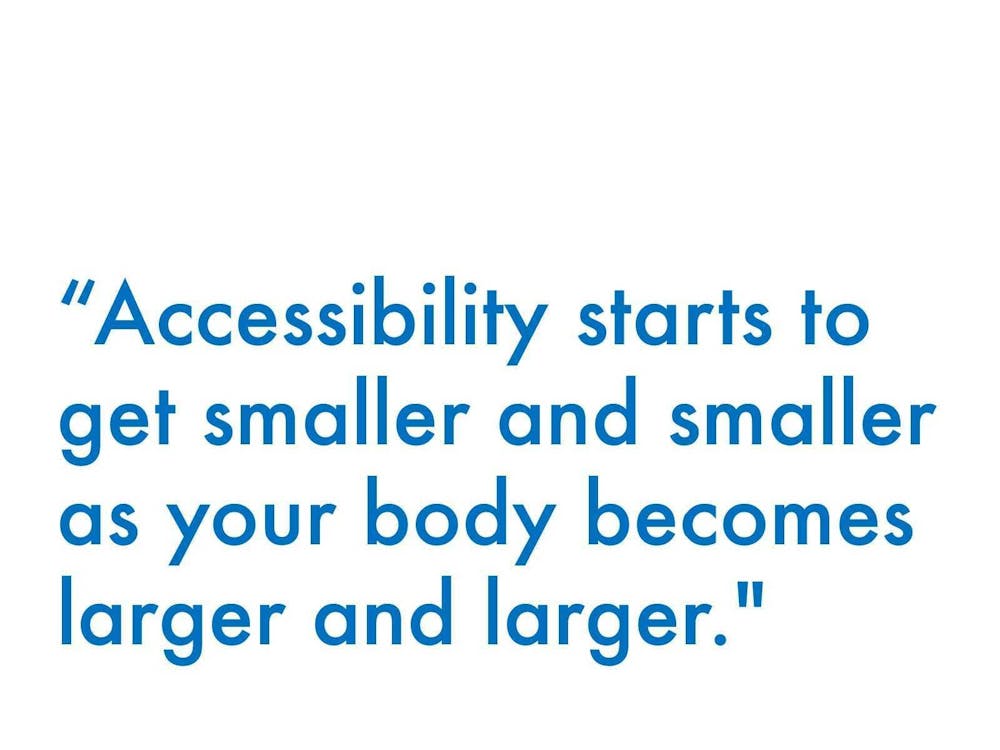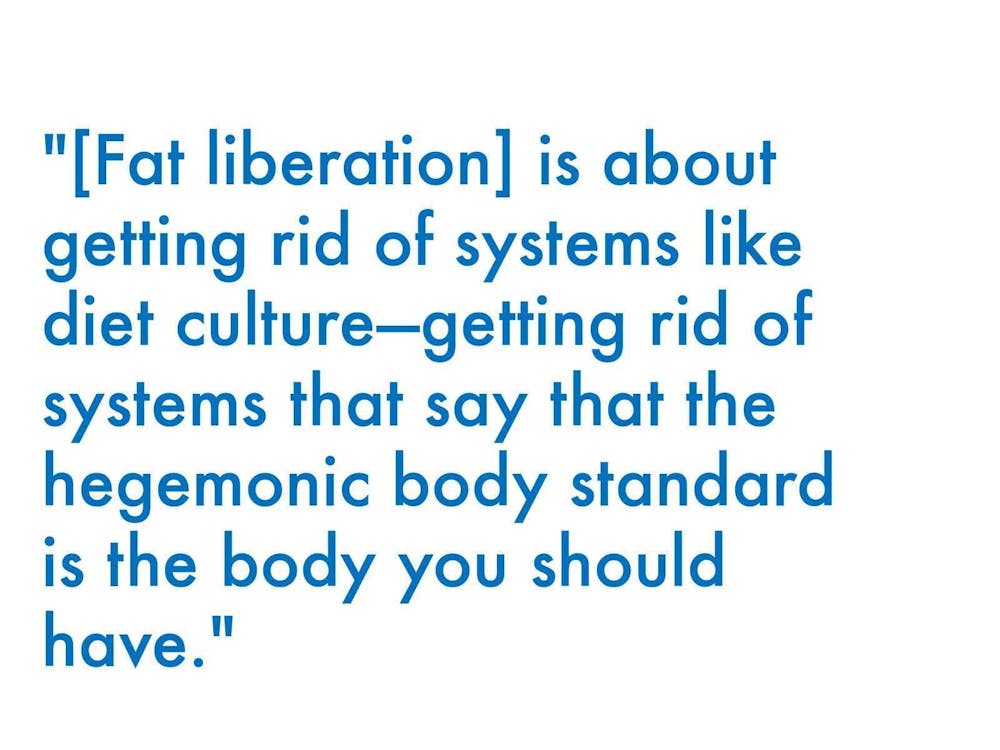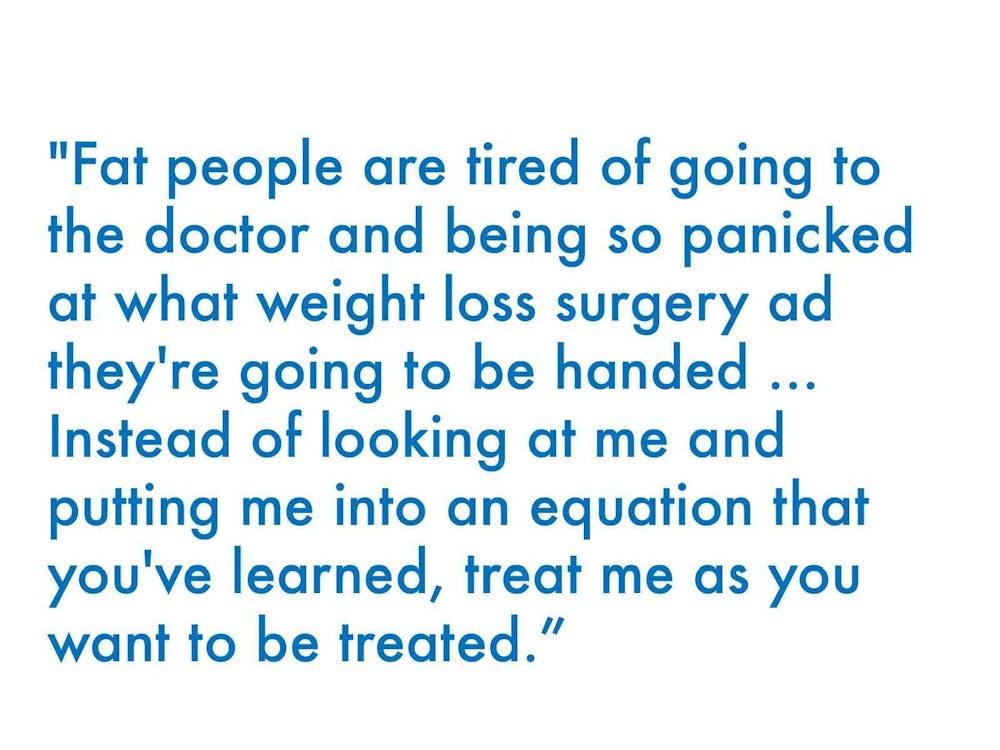Content warning: The following text describes eating disorders, medical fatphobia, body shaming, and bariatric surgery, which can be disturbing and/or triggering for some readers. Please find resources listed at the bottom of the article.
Since the COVID–19 pandemic shut down most colleges back in March, Angelina Moles has been teaching classes from a vintage orange rocker in her San Francisco apartment. It might be a bit of an unusual piece of furniture to teach from, but it’s a welcome relief from the chairs at San Francisco State University.
“One of the best things about being a virtual teacher now is I get to sit in a chair that fits my body, and that feels good,” Angelina says. “Whereas in my classroom, there were some rooms where I couldn't even sit in a desk to grade my students’ speeches. I’d have to stand in the back of the class because I couldn't actually fit into a desk.”
If you aren’t fat, this problem might never have crossed your mind—the way a right–handed person might not think about how a left–handed person gets ink smudges on their palm from writing. The world was designed and built for thin bodies, so that people in thin bodies wouldn’t even notice it was that way.
For Angelina, it’s impossible not to notice. “Accessibility starts to get smaller and smaller as your body becomes larger and larger,” they explain. “Not necessarily that your body can't do things, whatever that might be, but that the stores, and airplanes, and chairs, and desks no longer fit you.”
She describes her body as being in the “mid–fat to fat range” and has spent her entire life unlearning and fighting against fatphobia in all its forms. She also has blue hair and a killer sense of style, both of which are regularly featured on her Instagram @fiercefatfemme, which boasts over 35,000 followers.
Angelina teaches classes about fat studies in the Communications Departments at three universities—San Francisco State University, College of San Mateo, and City College of San Francisco—from an apartment that feels like a haven of acceptance.
In addition to the thrifted orange chair, a collection of “delicious fat art” adorns their wall and brightens up the space. They keep a tote bag with a screen–printed phrase on it—“Fatties Against Fascism”—hung on a nearby coat tree as a reminder of what they care about.
There is a large assortment of funky earrings hung in an adjacent corner, reflective of a mild addiction to accessories that Angelina developed during childhood. “As a fat kid, the one thing you could purchase at stores was accessories,” she says.
Oh, and there’s a donut purse. Because why not?
A big part of Angelina’s impact is made through her Instagram, @fiercefatfemme. She regularly posts images of her body, shares resources for learning about and coping with fatphobia, and amplifies the voices of other fat people—especially fat people of color. Her account is an example of fat people existing unapologetically, which is a crucial thing to represent.
But the biggest takeaway from Angelina’s social media is much deeper than just learning to accept how our bodies look. It’s about understanding how systemic fatphobia affects bigger bodies differently and more materially than smaller bodies.
Even among the most "woke" audiences, fatphobia is often considered an internal thought pattern, not a form of systemic discrimination and oppression. And given the current face of the body positivity movement on social media, it makes sense that this is the assumption. Despite having been created by fat Black women to blog about fashion for bigger bodies, #bodypositivity's top posts are almost all of thin white women.
The quintessential formula for a post under this hashtag is the half–and–half, where one side of the image depicts a thin woman posing and looking perfectly like the beauty standard, while the other side shows her hunched over trying to create rolls.
Of course everyone can feel insecure about their body—including thin people. And these insecurities have very real effects on the mental health of people of all sizes. But fat people also experience a litany of other things that thin people don’t: a lack of clothing options in larger sizes, inaccessible structures (like transit seating or desks), workplace and pay discrimination, and lower quality medical care. Flattening discussions of fatphobia to just the aspects of it that also affect thin people obscures the many systemic barriers that fat people face.
“You can be as positive about your body as you want to be,” Angelina says. “But that doesn't actually get at the changes that we need to have in order to have fat bodies take up space, and take up space with care and protection.”
This, Angelina explains, is a key difference between fat liberation and body positivity. Rather than focusing exclusively on how fatphobia and diet culture affect the way people perceive their own bodies, “[fat liberation] is about getting rid of systems like diet culture—getting rid of systems that say that the hegemonic body standard is the body you should have. It's also about disability studies. It's also about race. It's also about all of these intricacies.”
Throughout every aspect of their life—social media, interpersonal relationships, and their work as a professor—Angelina tries to incorporate this broad vision of a world without fatphobia and all the other –isms that overlap with it.

Growing up, Angelina saw food play an important role in her family dynamic. Her parents are Portuguese immigrants, and food was a major aspect of their culture that they brought with them to the United States. “Coming to the table together was an activity that we always did,” she says.
Most of her family was also fat. “I saw other bodies that looked like mine within my own family,” she remembers. Sure, there was still the occasional discussion about saturated fats or needing to eat more vegetables, but Angelina never felt like her body was something to be fixed or that the foods she ate were bad.
That all changed when her mother decided to undergo gastric bypass surgery.
Gastric bypass surgery is a process in which a surgeon divides the stomach into sections and rearranges the intestines, ultimately forming a pouch with a much smaller volume than a normal stomach would have. As one might expect, this surgery drastically changes how the digestive system responds to food and often results in rapid weight loss.
Despite it being an elective surgery, Angelina’s family presented it to her as if it was mandatory. “It was told to me that it was a life–saving thing, and she might die while going under the knife.”
Suddenly, the person Angelina looked up to most was risking her life to have a body less like theirs. Their mother had decided that having a fat body, which looked an awful lot like Angelina’s, was so bad that it was worth anything to lose weight.
“I constantly witnessed my mom at a battle with what food she could and could not eat,” they recall. “And it would affect the way we would come together for dinner because I would never be able to sit and eat with my family without my mom having to excuse herself to go throw up.”
For someone who used to go to her grandmother's house every weekend and make cookies, who used to see her family gather happily around a table to eat dinner, who used to look lovingly upon her parents' big bellies that mirrored hers, watching her mother struggle so much with food was upsetting.
“Whether or not I was realizing it at that age, I've definitely realized now … I understood my own body in relation to my mom's."
It wasn’t really until the seventh grade that Angelina began to process her feelings about her mother’s surgery. By that point, her sister had moved out and lost weight, and Angelina was old enough that her extended family thought it was appropriate to comment on her weight.
“I think before that, [my family] just thought, ‘Oh, you know, Angelina's a kid, you know. Their body's gonna do whatever a kid's body is gonna do,’” they recall. “But I think in high school, they were like, ‘Now this is the time where you can change your trajectory on how your body's going to look.’”
The new expectations placed upon her teenage body in combination with witnessing the aftermath of her mom’s surgery drove Angelina toward disordered eating. “I forced myself into having an eating disorder to be thinner and to change my body because the bullying was at its highest at that point,” she says.
Unfortunately, Angelina never sought help, in large part because of a long history of negative interactions with doctors. They already knew what the doctor would say—the same thing doctors say to so many fat patients every day, the same thing Angelina had heard their whole life: "Just lose weight."

“It makes me trust my doctor a whole lot less,” they say. “You're going to tell me I should be watching what I eat, and you don't actually know that every single waking moment of my life, I'm thinking about everything I eat—from the moment I wake up to the moment I go to sleep.”
A 2014 article by the American Psychological Association emphasizes that this is not an uncommon phenomenon: “Eating disorder diagnoses are delayed an average of nine months among patients who were once [classified as] overweight or obese when compared with patients who were never [classified as] overweight.”
(It's important to note that terms such as “overweight” or “obese,” although common descriptors used by medical professionals, are not preferred by many fat people—Angelina included.)
The most common reason that fat people are not diagnosed with eating disorders, if they seek help at all, is that most people actually encourage them to keep losing weight.
Reflecting on the reaction to her mom’s weight loss after the surgery, Angelina says, “It was watching her become smaller and seeing how much more people treated her with decency. That really confused me.” She cites seeing this reaction as part of the reason she began restricting her food intake.
But it isn’t only friends and family that contribute to this; doctors can also inadvertently contribute to disordered eating by blindly encouraging any instance of weight loss. Oftentimes, a doctor will praise a fat person for losing weight by restricting calories and over–exercising, when if a thin person did exactly the same things, it would be labelled an eating disorder.
“When I originally had my eating disorder, I never sought medical help for it because I felt like I failed at having an eating disorder,” Angelina says. “I was still fat. And I thought that the whole point of doing what I was doing was to not be fat. And I think that’s how a lot of medical providers see it, too.”
The first time Angelina experienced medical fatphobia was far earlier than most kids even start thinking about how much they weigh. “I was eight years old,” she says, “and the doctor told me I needed to stop eating Happy Meals because this was the moment that I would be able to control how fat I would get in the future.”
To some people, this might sound like benign nutritional advice from a health professional. We all know that the deep–fried meat and bland iceberg lettuce served by McDonald’s isn't the best source of vitamins and nutrients for kids’ developing bodies.
But Angelia points out that when these messages come constantly from all directions, when they are tied to appearance rather than well–being, and when they are presented as the solution to any and all health problems that fat people have, they can cause far more damage than they remedy.
“I think what a lot of fat people are asking for when they go to the doctor is to be listened to," she says. "When I come into [the doctor’s] office and say I'm having stomach pains, and I'm not sure what's going on, and it hurts when I do this,” she continues, bending over as if to pick up an object from the ground, “rather than looking at my body and seeing where the problem might be coming from, [the doctors refer to] this outdated, inaccurate BMI scale that we still use, look at me, and say, ‘Okay, I'm hearing you saying that you're having this pain. Okay, let's understand. Have you lifted something heavy? Maybe strained a muscle?’”
Medical student training often reaffirms, rather than deconstructs, anti–fat bias. A 2013 study of third–year medical students at the Wake Forest School of Medicine found that over one–third had “a significant implicit anti–fat bias,” but two–thirds of the students with such biases were unaware that they had them.
This can have disastrous consequences for fat patients. “Fat people are tired of going to the doctor and being so panicked at what weight loss surgery ad they're going to be handed,” Angelina says. “Instead of looking at me and putting me into an equation that you've learned, treat me as you want to be treated.”
There are some organizations working to change the way weight is talked about in the medical field. One notable initiative is the Health at Every Size (HAES) certification program, which seeks to create an “alternative to the weight–centered approach to treating clients and patients of all sizes,” while acknowledging the health needs of patients from a variety of backgrounds.
Despite these advancements, not enough medical professionals participate in such programs, and they continue to give worse care to fat patients. Research presented at the American Psychological Association’s conference in 2016 found that “doctors repeatedly advise weight loss for fat patients while recommending CAT scans, blood work, or physical therapy for other, average weight patients,” ultimately leading to worse health outcomes and longer waiting periods before diagnosis or treatment.
So what’s the solution? Angelina thinks the key is learning to see the patient as a whole person and not just as their weight or body size. “If healthcare providers can just take a second to put down the science textbooks and put down the articles that are quantitative rather than qualitative and try to actually look at each person's individual unique circumstances, I think we could have a much better healthcare system that focuses on actually giving care,” she says.
Since the first wave of lockdowns swept the country, there has been a lot of pressure on people to "use quarantine productively." You might have seen a listicle in your favorite news publication about all the new things you could learn, all the at–home exercises you could do, and all the Netflix shows you could binge.
You probably also heard about the 'Quarantine 15.'
A play on the infamous 'Freshman 15,' the 'Quarantine 15' refers to the phenomenon where, when you’re trapped in your house for days on end being anxious about the literal pandemic happening around you, you might gain a little weight. Who’d have thought that stress eating and a more sedentary lifestyle might come with a couple extra pounds?
Talking about this very normal weight gain like it’s a problem can exacerbate the struggles people have with body image and diet culture. In fact, a recent Scientific American article reported that the stress of lockdowns has actually contributed to higher rates of relapse or worsening restrictive behaviors for people who are in recovery from anorexia and bulimia.

The fear of the "Quarantine 15" also exposes how fatphobia is deeply embedded into our culture.
“You would think that during a global pandemic, when other things come to light, and when you start thinking about how drastically our world has to shift in order to take care of people, the fear of becoming fat would maybe take a backseat for a while,” Angelina says. “That's the opposite of what it did, actually. And I think that shows us that we as a society have a really big problem.”
Instead of fixating on weight gain, Angelina wants us all to take a big deep breath and remind ourselves to put things in perspective. “You're already dealing with processing how the world feels,” she says. “And isn't it amazing that [your body is] still getting up in the morning, that it's still telling you to eat, that it still feels soft and squishy and is holding your organs together, and is doing the best it can? Just like we're all doing the best we can. Why worry about if you went up one pant size, ten pants sizes, whatever it might be? That seems so arbitrary in the grand scheme of it all.”
Campus Resources:
The HELP Line: 215-898-HELP: A 24–hour–a–day phone number for members of the Penn community who seek help in navigating Penn's resources for health and wellness.
Counseling and Psychological Services: 215-898-7021 (active 24/7): The counseling center for the University of Pennsylvania.
Student Health Service: 215-746-3535: Student Health Service can provide medical evaluations and treatment to victims/survivors of eating disorders, regardless of whether they make a report or seek additional resources.
Reach–A–Peer Hotline: 215-573-2727 (every day from 9 p.m. to 1 a.m., texting available 24/7), A peer hotline to provide peer support, information, and referrals to Penn students.

